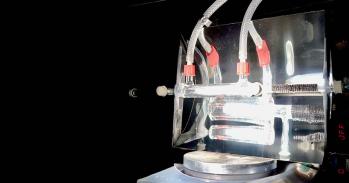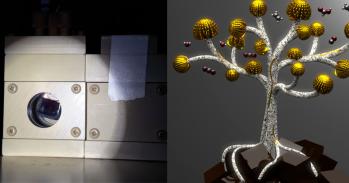
John Cornwell, director of Jesus College's Science and Human Dimension project, is also the author of a new biography of Cardinal John Henry Newman. The half-forgotten story of one of the 19th century's most important Catholic thinkers was one he found strewn with contradictory opinions, but ultimately also with lessons for our own time.
John Cornwell, director of Jesus College's Science and Human Dimension project, is also the author of a new biography of Cardinal John Henry Newman. The half-forgotten story of one of the 19th century's most important Catholic thinkers was one he found strewn with contradictory opinions, but ultimately also with lessons for our own time.
He once wrote that the heart is reached not by reason but by the imagination. What he was trying to do as a writer was to speak to the heart through the imagination.
John Cornwell on Cardinal Newman
John Cornwell's interest in Cardinal Newman began when he was a young seminarian at the age of 19. Rather against his will, a friend and enthusiast took him on a long trip across Birmingham, involving multiple bus-rides and lengthy walks, to find Newman's grave. It was the one day of the year when they were let out of the seminary for the entire period between mass and evening prayers, and Cornwell felt that the opportunity had been squandered on this seemingly needless mission. Afterwards, however, he had a sense that the spirit of the Cardinal was tugging at his sleeve, however, and it has never really left him since.
Cornwell has just written a study of Newman's life, but the process was a difficult journey in itself as his identity remains something of a mystery. Few people nowadays know who Cardinal Newman was and a mixture of often sharply contrasting interpretations of his life prevails. Before he began his work, a colleague in Cambridge suggested to Cornwell that Newman was a "pin-up boy for you Catholics". Just as many Catholics again, however, will have nothing to do with the man's memory.
Newman was born in 1801 and died in 1890, beginning his life in the age of sail and horsepower and ending it during the full flourish of the Victorian age. He was educated at Oxford and decided to become a priest in the Anglican Church, where he was one of a number of theologians who set about attempting to reverse the Church's perceived decay. Eventually, however, he became what Cornwell described as "perplexed" about the Anglican faith and switched to Catholicism. He became one of that Church's most eminent thinkers, a prolific writer, particularly on Christian apologetics, and eventually a Cardinal.
This unusual trajectory is one of the main reasons why his reputation is so mixed. In the mid-19th century, the number of people who saw him as a "Catholic pin-up" was matched by those who saw him as an apostate, (or pervert, to use the terminology and meaning of the age), who had abandoned the religion of his own family and thrown himself on the mercy of the idolatrous whore of Babylon. Within the Catholic Church, his liberal-minded theology caused a similar split in opinion. Pope Benedict is not a fan of Newman, for example; in the 19th Century, Leo XIII also found it hard to make him a Cardinal because of opposition within the Vatican from those who saw him as the most dangerous man in England.
The same confusion about Newman continues to affect his reputation. When in 2008 an attempt was made to dig up his body for purposes of beatification, it emerged that he had not been buried alone, but with a close friend, Ambrose St. John. Media excitement about Newman's sexual proclivities ensued - Peter Tatchell went on Newsnight to announce that he had read letters from Newman referring to St John as "my first and my last", but others claimed the Cardinal was "irrefutably heterosexual". Even his portraits leave us with a mixed picture, some showing him as thin, sallow and troubled, others depicting him as warm, strong and comfortable within himself. When in 1863, Newman was accused by Charles Kingsley of favouring the idea that it was acceptable to tell lies, he set about writing his great Apologia, to stop "the phantom that gibbers instead of me". According to Cornwell, a variety of such phantoms never stopped their gibbering.
In attempting to pin Newman down, Cornwell found the consistency he was looking for in his life as a writer. "The sheer range of his writing is what hits you first," he said. Newman wrote monographs, hymns, prayers, meditations and so many letters that, to date, 32 fat volumes of his correspondence also exist. It was the letters which Cornwell found especially compelling. As well as illustrating aspects of Newman's religious thought, they reveal his sharp business mind. "He could read a balance sheet as well as anybody," Cornwell suggested. "You get this extraordinary effect of so many diamonds sparkling set in lead."
The letters also show that Newman tussled, often painfully, with the act of writing. "He was trying to give some kind of energy and luminosity to the word on the page," Cornwell said. "He once wrote that the heart is reached not by reason but by the imagination. What he was trying to do as a writer was to speak to the heart through the imagination."
What emerges from this is that Newman's approach to theology was very different from the typical, abstract, logical, ahistorical Catholic mindset. He was clearly a sensitive man, who loved narrative and images. His work is full of similes, depicting the Church at times as a poet or a river, or seeing it in terms of geometry or architecture. It makes him a remarkably fresh voice within Catholic theology.
Cornwell thinks that by reading Newman in this sense we can, ultimately, understand something of his legacy. "What I feel he passes on to us is the tremendous importance of individual private judgement and conscience. The lesson of his life is never accept what your parents tell you, or your school tells you, or your church, mosque or synagogue tells you. Question everything. And be prepared to change."
Newman put this in theological terms, of course, believing conscience to be the "echo of the voice of God" inside us, telling us to pursue good and avoid evil. For Cornwell, this means that a man who was frequently under fire from both sides of the Anglican/Catholic divide nevertheless understood all humans to be "exalted" because of the echo of goodness inside them. He wrote also, in very poetic ways, of the fallen nature of human beings. Put together, Cornwell believes that these perspectives on the human condition give us a powerful basis on which to found mutual respect and a pluralistic society.
A second aspect of his legacy is his work on The Idea Of A University, which in its conception that a university should be about everything has become a blueprint for those setting up tertiary education institutions in various corners of the world. Tellingly, it was the point of reference for Edward Saeed, a social scientist of Palestinian origins, when he considered how such a higher education institution should be established in an Islamic state. "We live in a world where many Universities are becoming research intensive and this means our focus is on one track very early on," Cornwell said. "Newman is very clear about the fact that in a culture where this happens there can be very great dangers. An example would be BP in the Gulf of Mexico, which involved a preoccupation with making money and supplying energy without taking account of the historical or environmental aspects of the problem. Another example might be the Iraq War, where nobody thought forward sufficiently to how the country would be organised once the fighting was over. That tunnelvision has to start somewhere. It begins with the way we are encouraged to think, and Newman realised therefore that it happens with our education."
This work is licensed under a Creative Commons Licence. If you use this content on your site please link back to this page.





